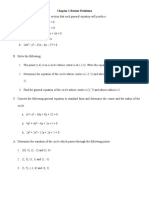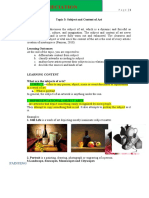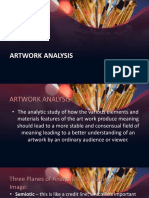Lecture Notes in Art Appreciation Class of Dr. Allan C. Orate
Lecture Notes in Art Appreciation Class of Dr. Allan C. Orate
Uploaded by
Kimberly Wealth Meonada MagnayeCopyright:
Available Formats
Lecture Notes in Art Appreciation Class of Dr. Allan C. Orate
Lecture Notes in Art Appreciation Class of Dr. Allan C. Orate
Uploaded by
Kimberly Wealth Meonada MagnayeOriginal Description:
Original Title
Copyright
Available Formats
Share this document
Did you find this document useful?
Is this content inappropriate?
Copyright:
Available Formats
Lecture Notes in Art Appreciation Class of Dr. Allan C. Orate
Lecture Notes in Art Appreciation Class of Dr. Allan C. Orate
Uploaded by
Kimberly Wealth Meonada MagnayeCopyright:
Available Formats
UNIVERSITY OF THE EAST
COLLEGE OF ARTS AND SCIENCES-MANILA
DEPARTMENT OF HUMANITIES AND PHILOSOPHY
LECTURE NOTES IN ART APPRECIATION
CLASS OF DR. ALLAN C. ORATE
MODULE 5
Art and Philosophy: Formalism,
Expressionism and Hedonism
M5. OBJECTIVES
At the end of the lessons, the students are expected to:
1. Relate the study of art to the field of philosophy.
2. Compare and contrast formalism, expressionism, hedonism and other theories of art.
3. Identify artworks, styles, artists that abide with formalist, functionalist and hedonistic theories.
4. Apply the theories to art analysis.
5. Interpret formalism as foundation of modern non-objective art.
6. Formulate a philosophical approach to the study of Art Appreciation.
7. Evaluate the merit or demerit of artworks using the principles of formalism, expressionism and
aesthetic hedonism.
8. Make works of art that show the application of the theories.
M5. READINGS
M5. READING 1. Kandinsky, Wassily (1911). “Theory” excerpt from Concerning the Spiritual
in the Arts, pp. 46-52 In http://www.semantikon.com/art/kandinskyspiritualinart.pdf
M5. READING 2. Tolstoy, Leo (1897). Excerpt from What is Art. In https://www.google.com.
ph/webhp?sourceid=chromeinstant&rlz=1C1RLNS_enPH670PH670&ion=&espv=2&ie=UTF8#
q=what+is+art+leo+tolstoy+pdf.
M5. VIDEOS
Topic Overview
M5. VIDEO 1. “Kandinsky and Schonberg” in https://www.youtube.com/watch?v=I0DXYT
N0OAM
M5. VIDOE 2. “ArtSleuth VAN GOGH, The Starry Night (final version)” in https://www.you
tube.com/results?search_query=Artsleuth+Van+Gogh+Starry+Night+MOMA.
M5. VIDEO 3. “Dirty Dancing: Time of Your Life” in https://www. youtube.com/watch?v=
WpmILPAcRQo
LECTURES IN ART APPRECIATION PREPARED BY DR. ALLAN C. ORATE 1
M5. LECTURES
Topic Overview
In the previous module, we define art as a copy of people, things or events. Now we look at art
according to its composition, according to the human emotion that it elicits from us, and according
to the pleasurable experiences that art affords us. Thus, art is appreciated in the sense of its form,
its emotional effect and its appealing quality. Just like in the art of sound, we might be interested
in the technical way of writing it through musical notation, for stimulating a patriotic purpose of
it such us singing the national anthem, or for simply enjoying the music while we take rest and
relaxation. Art is not only about the world, but it is about us because it relates to our feelings,
imagination and experiences.
M5. LECTURE 1
Formalist Theory of Art
Formalism is a theory which asserts that art is the combination of perceptual elements. Art is the
“form,” defined by George Santayana as “the sensuous elements in combination.” In the case of
painting, these are the visual elements such lines, shapes, value, texture and colors. This means
that, for example, what is appreciated in Mondrian’s Composition with Red, Yellow and Blue, are
only the combinations of three primary colors, the black vertical and horizontal straight lines, and
the squares and rectangular shapes. This painting is purely formal; it does not have representation,
emotional expression nor intellectual meaning.
The art theory of formalism was formulated b, Clive Bell. He writes: “to appreciate art, we need
bring with us nothing from life.” Bell claims that art is “only the significant form.” This is
similar to the famous quotation, “art for art’s sake,” by Theophile Gautier. It means that art has
no human responsibility; art exists only for itself. The application of formalism in modern art came
from the Paul Cezanne, who said: “artists need to look at things only as form made up of
spheres, cylinders and cones.” For instance, when you look at the full moon, you don’t see the
“moon” but you see a “yellow circle.” What you see in Cezanne’s Still Life with Apples are not
“apples” but “red circles and patches of yellow with black outline”.
In formalism, we see only the visual elements, but in representationism, we see images of things.
We look at a particular design: when we consider this design as representation, we see a “pine
tree”, but when we regard it as a form, we see a “green isosceles triangle on top of a long brown
rectangle”. In the same way, looking at The Mona Lisa, representationally, we see the eyes of the
woman, her nose and lips; we see the face and the arms. But formally, we see two small circles, a
triangle, a curve line and oblongs and elliptical shapes.
The notable formal paintings are those by Mondrian who made many variations of Composition
with Red, Yellow and Blue; the suprematist works by Kasemir Malevich such as Black Rectangle,
Blue Triangle; the op art paintings showing optical illusions by Bridget Riley and Victor Vasarely;
as well as the modernist pieces by Hernando Ocampo in Philippine art. There are also formal
designs in Badjao’s vinta and Tiboli’s tinalak. Islamic art is basically non-figurative. One artistic
feature is the arabesque or the formal, geometrical designs found in the walls and floors of
mosques and Islamic architectural works such as the Taj Majal in Agra, India.
LECTURES IN ART APPRECIATION PREPARED BY DR. ALLAN C. ORATE 2
In his book, Concerning the Spiritual in the Arts, Wassily Kandinsky said that representation in
the arts is brought by materialism of people in the society, and formal art seeks to bring out the
spiritual quality of art. “Art is born from the inner necessity of the artist in an enigmatic, mystical
way through which it acquires an autonomous life; it becomes an independent subject, animated
by a spiritual breath.” He created series of no-objective paintings in evolving forms, like Squares
with Concentric Circles, Impression V, Improvisation 28 and Composition 6.
M5. LECTURE 2
Expressionist Theory of Art
Expressionism emphasizes that art is the process by which the artists bring out their emotions. In
order for us to appreciate art, it is not enough that we perceive the form and the representation by
our senses, but we need to feel the art by our hearts. As art spectators, we experience the same
emotion that the artists have presented in their works.
Expressionism may be traced back from the view of the ancient Greek philosopher Aristotle. He
speculated on the so-called catharsis that refers to the artists’ overflowing emotion which they
divert into the process of art production. For Susanne Langer, “art is the creation of symbolic
forms expressive of human feeling.” Art is the “objectification of emotion,” according to Leo
Tolstoy. While Benedetto Croce’s intuitionism claims that art is like language which the artists
use to convey their ideas.
The emotional expressions in art are indicated by the visual elements, forms or representations.
Eemoticons are simple drawings of human faces depicting various feelings through the variations
of lines. Convex line means “happy”, concave means “sad”, while straight means “insensitive’.
The emotion in Leonardo’s The Mona Lisa is expressed by the line of the lips; the smile of the
woman is usually described as “enigmatic” or “mysterious”, but it could also mean “cheerful,”
“powerful”, “seductive” and “sinful”. In Amorsolo’s paintings, the smiling dalagang Filipina may
be an indication of fresh, innocent and peaceful disposition in life.
One expressionist painter is Edvard Munch. The theory of expressionism in implied in this
quotation form him: “For so long as I can remember, I suffered a deep feeling of anxiety which I
tried to express in my art.” His painting, The Scream, demonstrates terrible fear as shown by the
curving and swerving lines of red, orange and yellow in the sky, and by the somber colors of grey,
blue and brown on the river, as well as by the face of the woman with bulging eyes and elongated
mouth. Munch’s The Sick Child is said to be the painting which expressed the great sadness he felt
as a child due to the sickness and death of his elder sister.
The most famous painter in the theory and style of expressionism was Vincent van Gogh. He
made self-portraits which showed the transition of his personality. His masterpiece, The Starry
Night, was painted while he was confined in a mental hospital due to severe emotional depression.
In this painting, the dominance of blue is said to be symbolic of van Gogh sadness. The patches of
yellow in the canvas are the effects of his alcohol addiction. The curve and hazy lines in the clouds
are indications of his mental collapse and epileptic attacks. Having lost the will to live, van Gogh
committed suicide by shooting himself at the stomach. In reference to art, his emotion and insanity,
he wrote: “I put my heart and soul in my work, and have lost my mind in the process.”
LECTURES IN ART APPRECIATION PREPARED BY DR. ALLAN C. ORATE 3
M5. LECTURE 3
Aesthetic Hedonism
As an ethical view about human life, hedonism was formulated by Aristipus and Epicurus. They
believed that whatever is good is what brings pleasurable experience to the individual person. The
hedonists would say: “Eat drink and be merry, for tomorrow you die.” This means that we only
have one life, and when we die be become nothing at all. This insight is applied to aesthetics. In
the words of David Hume: “pleasure and pain, are not only necessary attendants of beauty
and deformity, but constitute their very essence.” Similarly, for Albert Faurot, painting,
sculpture and music are meant only “for giving pleasure and life enhancement.” According to
Immanuel Kant too, art is more of play and fun than of work, however, the person must be
disinterested to the pleasure which art provides.
There is some truth in aesthetic hedonism considering our common experiences of nature and art.
We find the rainbow beautiful because of the pleasure it presents to our eyes, while the sight of a
shit is ugly because of its terrible appearance and bad odor. When we listen to music we feel relax,
or when we watch a movie, we enjoy it. Art is beautiful because of the sensuous delight it affords
us. If the music is irritating to our ears, or the film is boring, they bring us pain, and thus ugly.
In culinary art, we appreciate the food not only because it is nutritious, but more because it is
delicious. When we eat lechon, we enjoyed the taste, and never minded its cholesterol that might
bring us high blood and heart attack. We tend to appreciate fast foods because they are delicious,
although they are not healthy for the body because of their artificial flavorings and taste enhancers.
In painting, we tend to look at what bring pleasure to the eyes, and we try to avoid painful sights.
For example, we enjoy seeing the The Mona Lisa, rather than the Woman in Pink by Chaim
Soutine. It is more favorable to behold the handsome face of Albrecht Durer in his Self-Portrait,
than the Grotesque Face of Scaramuchia by Leonardo.
In Hindu culture, there is the kama sutra which means the “way” or “art of pleasure”. It is a literary
and art form containing illustrations and texts which depict naked male and female bodies in
explicit sexual acts. Its purpose is to teach people the means to attain pleasurable and sensual states.
Hindus believe that the experience of pleasure is a stage in man’s life necessary to achieve spiritual
release or moksha. For them, the kama sutra is not a work of pornography, it is rather an expression
of their religion and deep spirituality.
LECTURES IN ART APPRECIATION PREPARED BY DR. ALLAN C. ORATE 4
You might also like
- Outlines Sem 7#-094 UOGDocument19 pagesOutlines Sem 7#-094 UOGadeel hassanNo ratings yet
- CA Who Uses Indigenous MaterialsDocument97 pagesCA Who Uses Indigenous MaterialsBurning Rose75% (4)
- Art As A Humanistic DisciplineDocument85 pagesArt As A Humanistic DisciplineFroilan TinduganNo ratings yet
- Mathematics in The Modern World 2021 2022Document21 pagesMathematics in The Modern World 2021 2022Lowela Joy Andarza100% (1)
- Art and Philosophy: Hedonism, Action Theory and Institutional TheoryDocument170 pagesArt and Philosophy: Hedonism, Action Theory and Institutional Theoryjames aguilarNo ratings yet
- ArtDocument8 pagesArtAlvin Naire Patacsil100% (1)
- DeLeon Defining The Filipino Through The ArtsDocument39 pagesDeLeon Defining The Filipino Through The ArtsEloi Hernandez0% (1)
- ,FMLRMLFRKNKRNDocument94 pages,FMLRMLFRKNKRNHello World50% (2)
- Art Appreciation - The Filipino Concept of ArtDocument25 pagesArt Appreciation - The Filipino Concept of ArtRex GonzalesNo ratings yet
- 2 Introduction To AnglesDocument7 pages2 Introduction To Anglesdexter abasNo ratings yet
- MIDTERM EXAMINATION (AutoRecovered)Document5 pagesMIDTERM EXAMINATION (AutoRecovered)odessa urgelNo ratings yet
- 1 3 Intro To Series Plus SummationDocument17 pages1 3 Intro To Series Plus SummationZender Drof100% (1)
- MATH1010 University Mathematics Supplementary ExerciseDocument24 pagesMATH1010 University Mathematics Supplementary ExercisepklfpklfNo ratings yet
- Module 2 - Art & The Perception of Reality-1Document13 pagesModule 2 - Art & The Perception of Reality-1Rhowee Mariano100% (1)
- 5 Normal DistributionDocument34 pages5 Normal DistributionLa JeNo ratings yet
- Measures of VariationDocument30 pagesMeasures of VariationJahbie ReyesNo ratings yet
- Lesson 1 What Is ArtDocument11 pagesLesson 1 What Is ArtJanna Andrea GeneraloNo ratings yet
- Worksheet 4.12 InductionDocument4 pagesWorksheet 4.12 InductionalixNo ratings yet
- Educ 7 MidtermDocument6 pagesEduc 7 MidtermIvy DiazNo ratings yet
- MATH 106 MidtermDocument24 pagesMATH 106 MidtermSandro SerdiñaNo ratings yet
- The Filipino Perspectives and Contexts of Culture and ArtsDocument97 pagesThe Filipino Perspectives and Contexts of Culture and ArtsOctavio PazNo ratings yet
- ExpressionismDocument22 pagesExpressionismIvee KimNo ratings yet
- Chapter 1 Coordinate Geometry and Conic SectionsDocument17 pagesChapter 1 Coordinate Geometry and Conic SectionsAik0% (1)
- Art Lecture 1Document77 pagesArt Lecture 1Elle100% (1)
- Chapter 1 Review ProblemsDocument21 pagesChapter 1 Review ProblemsAsuna YuukiNo ratings yet
- Art Appreciation Prelim - 2ND SemDocument2 pagesArt Appreciation Prelim - 2ND SemJinky Arisgado ObidoNo ratings yet
- Humanities and Art Appreciation An IntroductionDocument7 pagesHumanities and Art Appreciation An IntroductionKris Lyn SumayoNo ratings yet
- Module 2 Art Appreciation and The Human FacultiesDocument12 pagesModule 2 Art Appreciation and The Human FacultiesaaronampongolNo ratings yet
- Introduction To Statistics: ObjectivesDocument14 pagesIntroduction To Statistics: ObjectivesRosemarie AlcantaraNo ratings yet
- Medium of ArtDocument13 pagesMedium of ArtEdlyn ResuelloNo ratings yet
- LESSON 2, Mathematical Language, Symbols & SetsDocument59 pagesLESSON 2, Mathematical Language, Symbols & SetsnhichelcantosNo ratings yet
- Truth Tables and TautologiesDocument15 pagesTruth Tables and TautologiesCathiona LavinskiNo ratings yet
- Statistics and Probability Pretest Set BDocument2 pagesStatistics and Probability Pretest Set BMejoy Marbida0% (1)
- 2ndquarter BusMathDocument3 pages2ndquarter BusMathGinevieve GibertasNo ratings yet
- Politics and Governance LectureDocument32 pagesPolitics and Governance LectureJohn Remmel Roga100% (1)
- History of Math PDFDocument4 pagesHistory of Math PDFVanessa Mae RaraNo ratings yet
- STS - Intellectual RevolutionsDocument16 pagesSTS - Intellectual RevolutionsEzra GarciaNo ratings yet
- SculptureDocument13 pagesSculpturejulie anne mae mendozaNo ratings yet
- Module Topic 3 Gec 5-Art-AppreciationDocument8 pagesModule Topic 3 Gec 5-Art-AppreciationJayArt Amogis TemPoralNo ratings yet
- Elements of Visual Arts ReviewerDocument5 pagesElements of Visual Arts ReviewerElaine DondoyanoNo ratings yet
- 7.1 Define and Use Sequences SeriesDocument34 pages7.1 Define and Use Sequences SeriessohamNo ratings yet
- Lecture 5artDocument34 pagesLecture 5artBrylle Earl Carpina RebenitoNo ratings yet
- To Humanities: by Marc Darwin L. Ragojos, Ph. DDocument113 pagesTo Humanities: by Marc Darwin L. Ragojos, Ph. DMarc Darwin Ragojos100% (3)
- Angles of PolygonsDocument3 pagesAngles of PolygonsLhoy Guisihan Asoy IdulsaNo ratings yet
- Module 5 - Rizal S EssaysDocument39 pagesModule 5 - Rizal S EssaysJasmine RenéeNo ratings yet
- Art History WesternDocument68 pagesArt History WesternKeithlan Rosie Fetil LlanzaNo ratings yet
- Module Math in The Modern World 1Document187 pagesModule Math in The Modern World 1Princess Erika CanlasNo ratings yet
- Art AppreciationDocument28 pagesArt Appreciationbea0% (1)
- Lecture 1Document94 pagesLecture 1Adc ClamorNo ratings yet
- Mte M3L1 Reporting GRP 2Document68 pagesMte M3L1 Reporting GRP 2TOREMONIA, JULIETNo ratings yet
- Art Appreciation Module # 2Document15 pagesArt Appreciation Module # 2Crizlle MedelNo ratings yet
- The Literature of The WorldDocument21 pagesThe Literature of The WorldRichelleNo ratings yet
- LECTURE #1 Art As A Humanistic DisciplineDocument93 pagesLECTURE #1 Art As A Humanistic DisciplineMario MorenoNo ratings yet
- Art Appre Me ReviewerDocument6 pagesArt Appre Me ReviewergracieNo ratings yet
- Ge 3 Group1 PresentationDocument20 pagesGe 3 Group1 Presentationmargie ybañezNo ratings yet
- MODULE Art AppreciationDocument59 pagesMODULE Art AppreciationThrolaj Ben AbrisNo ratings yet
- MYA Final Statistics and ProbabilityDocument10 pagesMYA Final Statistics and ProbabilityZian Lei MienNo ratings yet
- Types and Genres of ArtsDocument21 pagesTypes and Genres of ArtsRenz Daniel R. ElmidoNo ratings yet
- Arts-Appreciation-module Chapter 1Document18 pagesArts-Appreciation-module Chapter 1Kris MartinezNo ratings yet
- Philosophers and Their Philosophies 1. Jean Paul SartreDocument6 pagesPhilosophers and Their Philosophies 1. Jean Paul SartrejxnieNo ratings yet
- Idea27 - S.Raube enDocument11 pagesIdea27 - S.Raube enJulia MarczukNo ratings yet
- THESISWOTDocument29 pagesTHESISWOTKimberly Wealth Meonada MagnayeNo ratings yet
- Mechanics and Rules of The Games FinalsDocument21 pagesMechanics and Rules of The Games FinalsKimberly Wealth Meonada MagnayeNo ratings yet
- OrMin 1st Top-UpDocument8,773 pagesOrMin 1st Top-UpKimberly Wealth Meonada MagnayeNo ratings yet
- M5. Lecture 1. Formalist Theory of Art (With Narration.c)Document21 pagesM5. Lecture 1. Formalist Theory of Art (With Narration.c)Kimberly Wealth Meonada MagnayeNo ratings yet
- Placement Term (Years) Fixed Interest RateDocument1 pagePlacement Term (Years) Fixed Interest RateKimberly Wealth Meonada MagnayeNo ratings yet
- Declaration of Philippine Independence Learning ActivityDocument1 pageDeclaration of Philippine Independence Learning ActivityKimberly Wealth Meonada MagnayeNo ratings yet
- General CompressionDocument14 pagesGeneral CompressionKimberly Wealth Meonada MagnayeNo ratings yet
- Martial Law Learning ActivityDocument2 pagesMartial Law Learning ActivityKimberly Wealth Meonada MagnayeNo ratings yet
- M12: Learning Activity: Guide Questions: 1. How Gene Therapy or Cell Therapy Can Help Cure Diseases?Document4 pagesM12: Learning Activity: Guide Questions: 1. How Gene Therapy or Cell Therapy Can Help Cure Diseases?Kimberly Wealth Meonada MagnayeNo ratings yet
- Module 4 - QuantityDocument12 pagesModule 4 - QuantityKimberly Wealth Meonada MagnayeNo ratings yet
- Assessment 4-Magnaye, KimberlyDocument4 pagesAssessment 4-Magnaye, KimberlyKimberly Wealth Meonada MagnayeNo ratings yet
- Module 3 - QuantityDocument15 pagesModule 3 - QuantityKimberly Wealth Meonada MagnayeNo ratings yet
- Masonry Works - 5Document6 pagesMasonry Works - 5Kimberly Wealth Meonada MagnayeNo ratings yet
- Module 1 - Assessment: Kimberly Wealth M. Magnaye Bsce Iv-1Document3 pagesModule 1 - Assessment: Kimberly Wealth M. Magnaye Bsce Iv-1Kimberly Wealth Meonada MagnayeNo ratings yet
- ABSTRACT ART Detailed PresentationDocument16 pagesABSTRACT ART Detailed PresentationsameehaNo ratings yet
- Bai Tap NG Pháp Anh 9 Kì 1Document102 pagesBai Tap NG Pháp Anh 9 Kì 1yenh01352No ratings yet
- Art App Midterm OutlineDocument7 pagesArt App Midterm OutlineJoan VolfangoNo ratings yet
- HolidayHomework 52521739746Document6 pagesHolidayHomework 52521739746justprachujyaNo ratings yet
- Interior Estemate For A.k.das HotelDocument10 pagesInterior Estemate For A.k.das HotelZaxis AicNo ratings yet
- The Subjects of Art and The MethodsDocument12 pagesThe Subjects of Art and The MethodsEddylyn MarieNo ratings yet
- Western Art HistoryDocument47 pagesWestern Art Historyhengruh67% (3)
- FauvismDocument20 pagesFauvismjordaliza buyagao100% (2)
- Notes g6Document3 pagesNotes g6Emma Fe Ranis Esclamado100% (1)
- JSS3 CCADocument5 pagesJSS3 CCAukejelamchukwusNo ratings yet
- Contemporary Arts - q2 - Week 6-8 - TarayaDocument12 pagesContemporary Arts - q2 - Week 6-8 - TarayaAngel SabanalNo ratings yet
- CPAR Finals ReviewerDocument7 pagesCPAR Finals ReviewerLouise AxalanNo ratings yet
- Art App ReviewerDocument5 pagesArt App Reviewerbrylla monteroNo ratings yet
- Dreams and NightmaresDocument14 pagesDreams and Nightmaresapi-297049384No ratings yet
- Artwork AnalysisDocument22 pagesArtwork AnalysisApril Jade MendozaNo ratings yet
- Method Statement For PaintDocument5 pagesMethod Statement For PaintEngr Muhammad Sohail67% (3)
- ARTS 9 Q1 Week1 Module 1 Francisco Pascual 1Document20 pagesARTS 9 Q1 Week1 Module 1 Francisco Pascual 1Jilyan Stephanie Alonzo100% (1)
- Contemporary Exam - 1ST QuarterDocument3 pagesContemporary Exam - 1ST QuarterLORMELYN JOY SAJULGANo ratings yet
- Art Analysis WorksheetDocument2 pagesArt Analysis WorksheetInChrist Harieboy LaganNo ratings yet
- Performance Task - Renaissance and Baroque Art ExpressionDocument2 pagesPerformance Task - Renaissance and Baroque Art ExpressionRyan CortezNo ratings yet
- Paul GauguinDocument4 pagesPaul GauguinОлександра ІваськоNo ratings yet
- Home Decor 193 1Document17 pagesHome Decor 193 1Anil Bisht100% (2)
- Patrick NG Kah OnnDocument2 pagesPatrick NG Kah OnnNie Shirly0% (3)
- Art Styles in Contemporary ArtDocument8 pagesArt Styles in Contemporary ArtChianti Gaming09No ratings yet
- Creating Painting and Coating Specifications For A Project Is A Detailed Process That Requires Consideration of Various FactorsDocument2 pagesCreating Painting and Coating Specifications For A Project Is A Detailed Process That Requires Consideration of Various FactorsgeevenNo ratings yet
- Learner's Activity Sheet Assessment Checklist: Contemporary Philippine Arts From The Regions Quarter 2 - Week 7Document17 pagesLearner's Activity Sheet Assessment Checklist: Contemporary Philippine Arts From The Regions Quarter 2 - Week 7Ken KenNo ratings yet
- Book 1Document46 pagesBook 1Fortune PaintsNo ratings yet
- ExpressionismDocument57 pagesExpressionismshaelNo ratings yet
- Gothic Architecture Thesis Defense by SlidesgoDocument11 pagesGothic Architecture Thesis Defense by SlidesgoGOWTHAMA SHANKAR GNo ratings yet







































































































